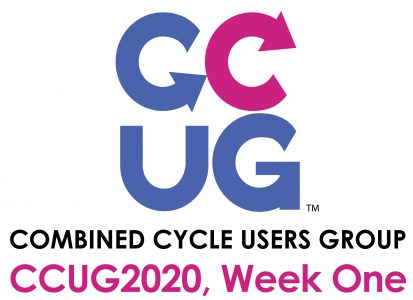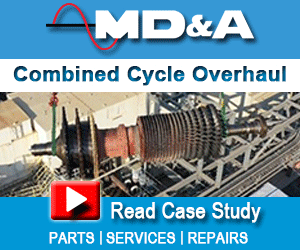The annual conference of the Combined Cycle Users Group is being conducted online for the first time this year. The four-week event, exclusive to owner/operators, began November 10 with a program focused on user experiences and vendor presentations. The latter were limited to 30 minutes each and conducted in two half-hour sessions. Each vendor was assigned a “breakout room” and users were connected to their presentations of choice. While attendees could not participate in more than two vendor presentations during the live Week One program, ALL presentations—both user and vendor—are available now on the Power Users website.
Highlights of the Week One user presentations, developed by the editors, are below.
Week Two (November 17-19) was GE Week, characterized by meaningful technical presentations, Q&A, and open discussion on topics of interest to the user community. Those presentations can be accessed through the OEM’s MyDashboard website.
Week Three’s CCUG program begins on Tuesday, December 1, at 9 a.m. Eastern with the first three hours allocated for private meetings with vendors; schedule these online just as you would a doctor’s appointment. Presentations by users are next, from noon to 2 p.m. followed by these two hour-long live vendor presentations with Q&A:
-
- HRST, 2 p.m., “Drum-Weld Critical-Crack-Size Pre-Outage Assessment and Application Experience.”
- Environex Inc, 3 p.m., “Is Your SCR/CO System Ready for Turndown? How Increased NO2/NOx Ratios Require Additional SCR Performance,”
A virtual vendor fair, complete with video chat rooms, runs from 4 p.m. until the end of the day’s program at 5.
CCUG2020 concludes with the Week Four program on December 8. Program format is the same as that for December 1. The featured vendor presentations on the last day of the conference are these:
-
- Orr Protection, 2 p.m., “Improving the Life Safety of CO2 Fire Extinguishing Systems.”
- Hydro Inc, 3 p.m. “Achieving Reliable Pump Operation for Non-Baseload Operation,” and “Innovations in Vertical-Pump Vibration Monitoring.”
CCUG2020, Week One user presentations
“Natural Gas Systems: Lessons Learned and Recommendations From Design to O&M,” can be thought of as a tutorial for ensuring safety and performance of gas supply and delivery in combined-cycle facilities, one which also addresses compliance with applicable specs—including ASME B31.1, NFPA 56, and NFPA 85.
Coverage includes LEL (lower explosive limit) detection and monitoring in general, mechanical- integrity inspections, buffer capacity, nitrogen purging, above- versus below-ground piping, change management and integration with the CMMS (computerized maintenance management system), and perhaps most importantly, analyzing all “near-miss” events, performing drills, and making sure your emergency plans are “dusted off.” A great “near-miss” real-world example illustrated is 500-psig fuel gas being trapped between two butterfly valves after shutdown and before some maintenance activities were about to commence in the area.
“Understanding Oil Analysis” likewise covered the tutorial aspects of contamination, fluid condition, and machine wear. Within each of these broad areas, the presenter reviewed the efficacy and cost of specific test procedures, and aspects of testing that can cause problems. For example, the temperature at which a demulsibility (ability to separate oil from water) test is performed can affect the results, something that is especially important for steam-turbine systems. Presenter recommended that someone at the site “needs to have formal third-party or in-house training” in all aspects of oil analysis.
HRSG pressure-wave cleaning. This writer’s jaw dropped to the floor faster than the material removed from an HRSG during a pressure-wave cleaning when he heard that 25 to 30 tons of rust and scale were removed, the pile at the HRSG floor was 14 in. deep, and the HRSG differential pressure dropped from 21 in. H2O to 8-10 in. Some important points for a successful cleaning: Allow only permitted blasting crews to access HRSG during the procedure, notify your neighbors, cover the backside of the SCR with a tarp, cover manway access doors, and clear CEM lines to make sure they don’t get plugged up.
Cold layup and restart. Powerplants want to be run. But when the market dictates otherwise for long periods of time, the plant has to go into cold layup. When the market further dictates that half of the plant capacity is sold into the market before the balance, well, the complications grow. The litany of issues which had to be addressed for a California plant under these circumstances are reviewed in “Plant Extended Layup and Restart Guidelines.” This presentation is a veritable study guide for the next plant that has to do this.
One of the most important lessons learned is that the turbine lube-oil preservative recommended by one vendor and applied was a poor choice and caused significant issues. Another is that calcium products from the vapor-phase corrosion inhibitor used for metal surfaces can get into the lube-oil system. Removing it is similar to removing varnish from lube oil. A third is that zero liquid discharge and air-cooled condensers can contribute to significant issues managing rinse and flush water. This plant also reported experience with GE’s proprietary pressure-wave cleaning method for HRSGs as part of the restart.







